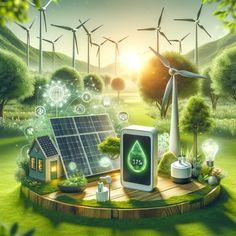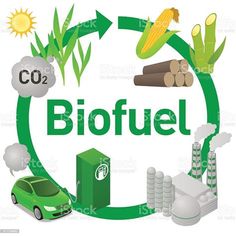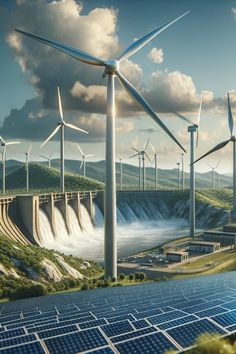Introduction: A Crossroads for Humanity

Imagine a world choked by smog, ravaged by relentless heat waves, and battered by increasingly violent storms. This isn’t a dystopian future; it’s the alarming reality we face if we continue our reliance on fossil fuels. The recent record-breaking wildfires in California and the devastating floods in Asia are just a glimpse into the disruptive effects of climate change, a crisis fueled by the burning of coal, oil, and natural gas.
The problem goes beyond environmental devastation. Our dependence on fossil fuels creates a fragile energy ecosystem. Volatile prices expose economies to sudden shocks, and dwindling resources raise concerns about long-term energy security. But amidst this darkness, a beacon of hope shines sustainable energy.
Sustainable Energy: Powering Our Future
Sustainable energy refers to resources harvested from sources naturally replenished on a human timescale, such as sunlight, wind, and geothermal heat. These resources address environmental concerns and offer a path toward energy independence and economic prosperity. The core principles of sustainable energy are:
- Renewability: Derived from continuously replenished sources, ensuring a reliable and long-term energy supply.
- Environmental Friendliness: Produces minimal greenhouse gas emissions and minimal environmental impact.
- Cost-effectiveness: Continually becoming more affordable and competitive with traditional fossil fuels.
The Benefits of a Sustainable Energy Future

Transitioning to clean energy sources offers a multitude of benefits that span the environment, economy, and public health:
- Environmental Benefits: By reducing our reliance on fossil fuels, we can significantly decrease greenhouse gas emissions, mitigate climate change, and improve air quality. This will lead to a healthier planet, cleaner air for all, and a more sustainable future for future generations.
- Economic Benefits: The shift to sustainable energy presents a vast opportunity for economic growth. Innovation in renewable energy technologies will create new jobs in manufacturing, installation, and maintenance. Reduced dependence on imported fossil fuels can strengthen energy security and boost domestic economies.
- Public Health Benefits: Transitioning away from coal-fired power plants will significantly reduce air pollution, improving public health. Cleaner air translates to fewer respiratory illnesses, reduced healthcare costs, and a healthier overall population.
The Current Landscape of Sustainable Energy: A Glimpse into a Cleaner Future

The fight against climate change and the pursuit of a sustainable future hinge on our ability to harness the power of renewable energy sources. These naturally replenished resources offer a cleaner and more secure alternative to fossil fuels. Let’s explore the established players in the renewable energy landscape, their strengths and weaknesses, and the supporting technologies crucial for a successful transition.
The Powerhouse Players: Established Renewables
- Solar Energy: The sun’s rays hold immense potential. Photovoltaic (PV) panels convert sunlight directly into electricity, making them a versatile option for homes, businesses, and utility-scale installations. Concentrated Solar Power (CSP) plants use mirrors to focus sunlight onto a receiver, generating heat to produce electricity through a steam turbine.
- Advantages: Solar energy is a clean and abundant resource with minimal operating costs. Technological advancements have driven down costs, making solar increasingly competitive.
- Limitations: Solar energy production depends on sunlight availability, making it intermittent. Energy storage solutions are crucial for consistent power delivery. Additionally, large-scale solar farms can have a land-use footprint.
- Wind Energy: Wind turbines convert the kinetic energy of moving air into electricity. They can be installed onshore or offshore, with offshore winds offering more robust and more consistent wind speeds.
- Advantages: Wind energy is a clean and readily available resource with significant technological advancements leading to increased efficiency. Wind farms can generate large amounts of electricity and are well-suited for areas with consistent winds.
- Limitations: Wind energy can be visually disruptive and raise concerns about noise and potential impact on wildlife. Wind speeds can be variable, affecting power generation.
- Hydropower: Dams harness the power of moving water to generate electricity through turbines. Hydropower is a mature and reliable renewable energy source, especially in regions with abundant rivers and suitable topography.
- Advantages: Hydropower plants can be highly efficient and reliable, offering dispatchable power to adjust electricity generation based on demand.
- Limitations: Building large-scale dams can significantly impact ecosystems and communities living downstream. Additionally, hydropower is dependent on sufficient water flow, which can be affected by climate change.
- Geothermal Energy: The Earth’s internal heat can be harnessed to generate electricity through geothermal power plants. This clean and reliable source utilizes steam from geothermal reservoirs to drive turbines.
- Advantages: Geothermal energy is a baseload source, meaning it can provide constant and reliable electricity generation. It has a minimal land-use footprint compared to other renewables.
- Limitations: Geothermal resources are geographically limited to areas with hot springs or volcanic activity. Exploration and drilling for geothermal energy can be expensive.
- Biomass Energy: Organic matter like wood chips, agricultural waste, or specially grown energy crops can be burned to produce electricity or heat.
- Advantages: Biomass is a readily available renewable resource that can be used for baseload power generation. It can also be a source of biofuels for transportation.
- Limitations: Large-scale biomass use can raise concerns about deforestation and competition with food production. Burning biomass releases some greenhouse gases, although generally less than fossil fuels.
Efficiency: The Missing Piece of the Puzzle
More than simply increasing renewable energy generation is required. Implementing energy efficiency measures plays a crucial role in reducing overall energy demand and maximizing the impact of renewable sources. This can involve:
- Upgrading buildings with energy-efficient appliances, lighting, and insulation.
- Adopting energy-saving practices in homes and businesses.
- Promoting industrial processes that consume less energy.
By reducing demand, we can better use the clean energy generated from renewable sources.
Smart Grids: The Power of Interconnectivity
Traditional power grids were designed for a one-way flow of electricity from large power plants to consumers. Smart grids, with their advanced technology and two-way communication capabilities, offer a more dynamic and efficient solution:
- Optimizing Distribution: Smart grids can optimize energy distribution based on real-time demand, minimizing losses and ensuring efficient delivery.
- Integrating Renewables: The intermittent nature of some renewable sources can be addressed by smart grids, which can integrate them seamlessly into the overall power system.
- Consumer Participation: Smart grids empower consumers to participate in energy management through smart meters and demand-response programs.
The synergy between established renewable energy sources, energy efficiency practices, and smart grid technology is paving the way for a more sustainable energy future.
Innovative Solutions for a Sustainable Energy Future
The current landscape of renewable energy offers a solid foundation, but innovation constantly pushes the boundaries of what’s possible. Let’s delve into some promising emerging technologies that hold immense potential for a clean energy future:
Emerging Renewable Energy Technologies: Power Beyond the Horizon

- Ocean Energy: The vast power of the ocean can be harnessed through various technologies:
- Wave Energy: Wave converters capture the kinetic energy of waves to generate electricity. While still under development, this technology offers significant potential in coastal regions.
- Tidal Energy: Tidal currents, caused by the gravitational pull of the moon and sun, can be harnessed by underwater turbines to generate electricity. This predictable source holds promise, particularly in areas with tidal solid movements.
- Ocean Current Energy: Similar to tidal energy, underwater turbines can extract energy from the constant movement of ocean currents.
- Advanced Geothermal Technologies: Beyond traditional geothermal power plants, innovative approaches are emerging:
- Enhanced Geothermal Systems (EGS): This technology utilizes artificial techniques to create geothermal reservoirs in areas with limited natural resources, expanding the potential reach of geothermal energy.
- Concentrated Solar Thermal with Energy Storage: Concentrated Solar Power (CSP) plants can be coupled with energy storage solutions like molten salts to address their intermittency. This allows for the storage of excess solar energy during peak daylight hours and the release of it to generate electricity when needed.
- Bioenergy with Carbon Capture and Storage (BECCS): This technology combines biomass energy production with capturing and storing the carbon dioxide emissions that would otherwise be released. BECCS can potentially be a carbon-negative technology, actively removing greenhouse gases from the atmosphere.
- Hydrogen Energy: Hydrogen offers a clean and versatile energy carrier when produced from renewable sources (green hydrogen). It can be used in fuel cells to generate electricity, power vehicles, or store excess renewable energy. However, challenges remain in hydrogen production, storage, and transportation.
Energy Storage Solutions: The Key to Unlocking Renewables’ Full Potential
The intermittent nature of some renewable energy sources, like solar and wind, can be addressed through efficient energy storage solutions. These technologies are crucial for ensuring a reliable and stable electricity grid powered by renewables:
- Pumped Hydro Storage: This mature technology uses surplus electricity to pump water uphill to a reservoir. During peak demand periods, the water is released back down through turbines to generate electricity.
- Battery Storage: Lithium-ion batteries are currently the dominant technology for grid-scale energy storage. However, research is ongoing to develop more efficient, higher capacity, and lower-cost battery alternatives beyond lithium-ion.
- Compressed Air Energy Storage (CAES): This technology stores excess energy by compressing air into underground caverns. Compressed air is released to drive turbines and generate electricity when needed.
- Thermal Energy Storage: This technology stores thermal energy from concentrated solar power plants using molten salts or other materials. The stored heat can then generate electricity when solar radiation is unavailable.
Decentralized Energy Systems: Empowering Communities for a Resilient Future
The traditional, centralized model of energy generation and distribution is evolving. Decentralized energy systems, consisting of smaller-scale renewable energy sources and local storage options, offer several advantages:
- Community Empowerment: Local communities can generate electricity, reducing dependence on centralized grids and fostering energy independence.
- Increased Resilience: Decentralized systems are less vulnerable to disruptions affecting centralized grids, improving overall energy security.
- Enhanced Efficiency: Energy losses during transmission and distribution are minimized in decentralized systems.
The rise of rooftop solar panels, microgrids powered by renewable sources, and community-owned renewable energy projects are all examples of this growing trend. By embracing these innovative solutions, we can unlock renewable energy’s full potential and create a sustainable energy future. However, the road ahead has challenges, which we will explore in the next section.
Challenges and Opportunities on the Road to Sustainability
While innovation offers exciting possibilities, the journey towards a sustainable energy future has hurdles. We must address these challenges while capitalizing on the vast economic opportunities.
Technological Challenges:
Despite their immense potential, some renewable energy technologies require ongoing research and development to ensure widespread adoption:
- Improving Efficiency: While significant advancements have been made, further improvements in capturing and converting energy from renewable sources are crucial for maximizing output.
- Scalability: Scaling up some emerging technologies, like ocean energy or enhanced geothermal systems, will be essential to meet large-scale energy demands.
- Cost-Effectiveness: While costs have come down for many renewables, further reductions are needed to make them fully competitive with fossil fuels across the board.
Policy and Regulatory Frameworks:
Supportive government policies and regulations are crucial for accelerating the transition to sustainable energy:
- Incentives for Renewables: Financial incentives like tax breaks, feed-in tariffs, and subsidies can encourage investment in renewable energy projects and make them more cost-competitive.
- Carbon Pricing: Implementing a carbon tax or cap-and-trade system can create a disincentive for fossil fuel use and encourage the adoption of cleaner energy sources.
- Streamlined Permitting Processes: Simplifying permitting processes for renewable energy projects can expedite development and deployment.
Infrastructure Development:
Integrating a high penetration of renewable energy sources requires a modernized energy infrastructure:
- Grid Modernization: The current grid may need to be equipped to handle the intermittency of some renewables. Upgrading the grid with intelligent technologies and expanded transmission capacity is crucial.
- Energy Storage Infrastructure: Investing in large-scale energy storage solutions is key to ensuring a reliable and stable electricity grid powered by renewables.
- Building a Smart Grid: Developing a smart grid infrastructure can optimize energy distribution, integrate renewables seamlessly, and empower consumer participation.
Social and Environmental Considerations:
Not all renewable energy solutions are without potential drawbacks:
- Land-Use Impacts: Large-scale solar and wind farms can have a land-use footprint. Careful planning and responsible siting practices are essential to minimize environmental impacts.
- Wildlife Concerns: Wind turbines can pose a threat to birds and bats. Mitigation strategies and responsible siting can help minimize these risks.
- Community Acceptance: Gaining public acceptance for renewable energy projects in local communities requires transparent communication, addressing concerns, and ensuring equitable benefits.
Economic Opportunities:
The transition to a sustainable energy future presents a wealth of economic benefits:
- Job Creation: The clean energy sector is a rapidly growing job market, offering opportunities in manufacturing, installation, maintenance, and research.
- Reduced Reliance on Fossil Fuels: Transitioning away from imported fossil fuels can improve energy security and reduce reliance on volatile energy markets.
- Long-Term Cost Savings: While upfront costs for renewables may be higher, the long-term operational costs are often lower than fossil fuels. Additionally, clean energy’s environmental and health benefits can lead to significant cost savings in the long run.
By acknowledging the challenges, implementing supportive policies, and embracing innovation, we can unlock the immense potential of a sustainable energy future. The transition will require collaboration between governments, businesses, and individuals, but the economic and environmental rewards are worth the effort.

